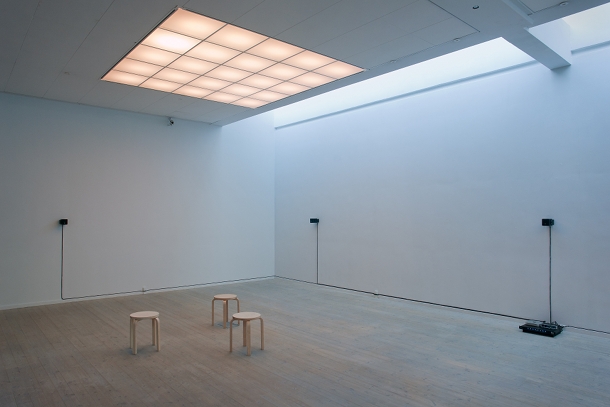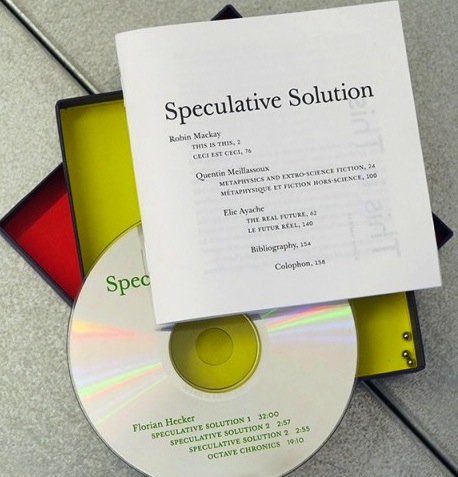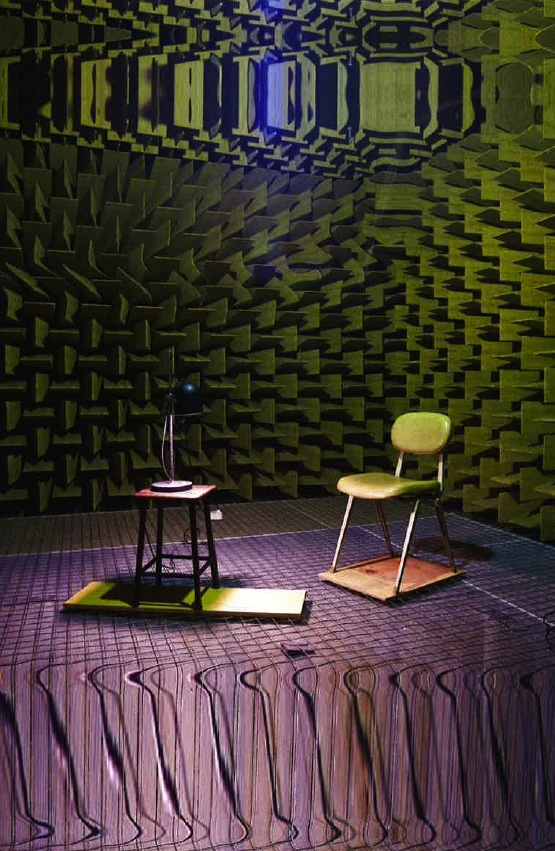Text: Janne Vanhanen
In contemporary art, the medium of sound is very much audible today. Even though the auditory domain has been present in art from 1960’s intermedial and interdisciplinary developments onward, the word “sound art” seems to have become established fairly recently as a term gathering together just about anything related to sound in an art institutional setting. No biennale or larger group show today would neglect sound-based works, and major exhibitions have been devoted to sound art exclusively.
However, in this “naturalization” process of the concept – sound art as denoting a sound installation in a museum or gallery context – there is the danger of losing sight of the transversal connections and diverse genealogies of sound in art. For instance, one can track the influence of experimental music, psychoacoustic research and conceptual art in contemporary sound art. Similarly, the development of sound synthesis, study of film sound, Futurist musical manifestos and avant-garde sound poetry could be regarded as important histories of sound in art, to name but a few.
 1)
1)
The questions of context, history and influence come to mind when presented with recent installations and records of musician and sound artist Florian Hecker, whose work has appeared in an increasingly interdisciplinary setting. What characterizes Hecker’s output is that it seems deliberately situated on an unstable ground between music (with name tags such as electronic music, experimental music, “extreme computer music,” digital noise etc.), academic research (philosophical essays and psychoacoustics of sound as basis for works) and modernist fine art (the “white cube” setting of his installations).
Correspondingly, Hecker has quite considerable discography of releases from the past 15 years, issued on well-regarded electronic music labels such as Editions Mego, Rephlex and Warp. He has collaborated with philosophers associated with theories of so-called “Speculative Realism” or “Continental realism,” Quentin Meillassoux, Reza Negarestani and Robin Mackay. And his works cross over from the context of music into that of art, as he has exhibited sound installations at, for instance, Fondation Louis Vuitton in Paris, New York’s MoMA and Guggenheim museums, and Documenta 13 exhibition in Kassel.
The purely sensory presence of Hecker’s sound pieces offers an enormously singular experience and we encounter a very idiosyncratic sound, but one that also arrives in a dense network of theoretical references. This infuses the works’ reception with certain tension: what relation can be discerned between the actual sound experience and its theoretical foundation – between noise and word? Does the conceptual content offer a key to understand the sensory experience, or vice versa? Do we need to “understand” the one or the other?
I wish to consider these questions via Hecker’s three recent works, Articulação (2014), Chimerization (2012) and Speculative Solution (2011).
Sound Object Oriented Ontology
Despite the wide range of possible contexts, there is a specific, even severe clarity in Hecker’s works that is reminiscent of high modernist sculptural ethos of producing distinct objects. The listener encounters sound objects that do not make any concessions towards a participatory relationship to the audience, but are encountered on their own terms; autonomous, even monolithic. Hecker’s installations follow an austere aesthetic, presenting loudspeakers in an otherwise empty space, arranged in a fashion that directs the audio content in spatial spread and gives the impression of sculptural sound in three dimensions.
 2)If considered as music, the works defy expectations of musical characteristics such as temporal flow, development of forms or dramatic structures. Instead we are typically presented with pristine digital shards of discrete object-like sounds, arranged in series. They raise the question of the objectuality of audio. Sound perception is the result of interaction between a vibrating sound source, a medium and a recipient receiving these vibrations. As this interaction is inherently processual and thus temporal, can sounds be thought of as objects? Certainly sounds appear in our perception bearing very different qualities than visual objects – sound is rather like an invisible force field in which we are immersed spatially and temporally.
2)If considered as music, the works defy expectations of musical characteristics such as temporal flow, development of forms or dramatic structures. Instead we are typically presented with pristine digital shards of discrete object-like sounds, arranged in series. They raise the question of the objectuality of audio. Sound perception is the result of interaction between a vibrating sound source, a medium and a recipient receiving these vibrations. As this interaction is inherently processual and thus temporal, can sounds be thought of as objects? Certainly sounds appear in our perception bearing very different qualities than visual objects – sound is rather like an invisible force field in which we are immersed spatially and temporally.
The sounds Hecker produces generally fall into two categories. The first consists of abstract, digital creations ex nihilo – “Meaningless, Affectless, Out of Nothing,” as the subtitle to “Modulator” from Articulação states – with no acoustic phenomena as their basis. They feel like objects, singular unities, and yet alien, something that does not settle within the scope of experience. Akin to abstract visual art, these virtual sounds present a challenge to language’s descriptive capacity, as we need to resort to metaphorical enunciations in order to refer to these “meaningless” sounds that evoke textural, spatial and other multimodal associations.
This type of audio abstraction can be contrasted with Hecker’s more recent use of recorded spoken word material that undergoes drastic manipulation by computer algorithms and results in ghostly fragments of speech mired in distortion and audio mirages. In listening to these, one notices how the human perception system is immediately at work to sift through the sound material in order to separate half-heard words out of interference, signal out of noise.
Hecker’s works often play with human perception, producing a hallucinatory or schizophrenically bifurcated experience. This adds a self-referencing layer to the “pure” sound of the audio content and forces the listener to consider the process of listening itself. It is telling that accompanying notes to Hecker’s works often refer to research in psychology of hearing by Diana Deutsch and Albert S. Bregman on the topic of auditory perception and illusions.
Chimeric Voices
 3)Another layer of reference is added by Hecker’s use of written text as the generative element of his latest output. In Speculative Solution, a booklet of 160 pages is included with the audio compact disc. Commissioned texts by philosophers Robin Mackay, Quentin Meillassoux and Elie Ayache accompany the music, elaborating the concept of “hyperchaos” – chaos not as undifferentiated miasma but a state of complete contingency that can generate structure as well as transform and destroy it. In the light of this concept, Hecker’s formally unpredictable and alien-sounding audio works begin to feel somehow analogous to the theoretical content. (Additionally, the box for CD and booklet contains five small metal balls rolling freely among the contents. They get lost easily and one imagines that the eventual misplacement of the spherical objects undoubtedly provides a further lesson on contingency and hyperchaos.)
3)Another layer of reference is added by Hecker’s use of written text as the generative element of his latest output. In Speculative Solution, a booklet of 160 pages is included with the audio compact disc. Commissioned texts by philosophers Robin Mackay, Quentin Meillassoux and Elie Ayache accompany the music, elaborating the concept of “hyperchaos” – chaos not as undifferentiated miasma but a state of complete contingency that can generate structure as well as transform and destroy it. In the light of this concept, Hecker’s formally unpredictable and alien-sounding audio works begin to feel somehow analogous to the theoretical content. (Additionally, the box for CD and booklet contains five small metal balls rolling freely among the contents. They get lost easily and one imagines that the eventual misplacement of the spherical objects undoubtedly provides a further lesson on contingency and hyperchaos.)
More literal connection between language and sound is provided by subsequent works. The compact disc issue of Articulação contains two pieces called “Hinge” where the original sound material is produced by the reading of a philosophical “libretto” written by the Iranian philosopher Reza Negarestani. A similar approach was adopted in the preceding Chimerization work, presented originally as an installation at the latest Documenta exhibition with three language variations (English, German and Farsi) of a text written by Negarestani. Both of Negarestani’s libretto texts explore from a philosophical point of view the seemingly unbreakable schism between the concepts of nature and culture and the possibility of the human faculties of reason and imagination to act as hinges between these disparate domains.
Given the philosophical emphasis of these sound works, it would seem that here we encounter the melding together of word and sound – an arrangement in which the actual sonic manifestation of the work would be totally subsumed under the conceptual domain. Yet, despite their textual origins, Hecker’s works are not straightforward spoken word pieces where the semantic content would be prioritized, since the articulated material, speakers recorded in “dead” acoustic conditions in sound-proof anechoic chambers, undergoes a process of extensive digital transformation on its way to the final work.
This process Hecker nominates “chimerization” and it forms a major strand of his artistic research. Chimerization refers to ancient Greek mythological creatures that are composed of parts of more than one animal. The chimera was, in the words of Homer, “lion-fronted and snake behind, a goat in the middle” (Iliad 6.181). Modern chimeras can be found in experimental genetics, where a single organism can be produced by growing it from genetically distinct cells, as well as in the medical practice of combining different tissues in one individual in a transplant operation. The result is not a synthetic hybrid, which would merge the genetic content of both lineages, but a mixture which retains the characteristics of both ancestors.
![]() 4)
4)
In terms of audio content, the process of chimerization means, for Hecker, the grafting together of characteristics of different sounds in a new mixture, which nevertheless displays dissimilar qualities. The timbre or “color” of one sound can be modified to adopt the dynamic of another, to take a fairly straightforward example. Already the techniques of musique concrète included the splicing of familiar sounds into an uncanny shape – changing the gradual “attack” envelope of a bowed instrument into a quick burst like that of a snare drum etc. Contemporary digital resources in audio manipulation have made the possibilities of such production of sonic chimeras almost limitless.
In Chimerization the singular foundation provided by the text is eroded as the voices of different speakers are chimerized together. This results in vocal fragments, traces and phonemes among bursts of noise. The increase in the complexity of material loosens the causal and semantic ties to any supposed origins of individual sounds. Film sound theorist Michel Chion has produced a well-know model of three different modalities of listening, that is, categorizations of the different “objects” our listening addresses. (1) The first two modes are quite commonplace and utilitarian, in these we refer primarily to the cause of a sound and to the meaning it conveys. The third mode is “reduced listening” and it is modelled after phenomenological reduction. Chion derives it from the French pioneer of musique concrète, Pierre Schaeffer. The object of reduced listening is the sound itself as a material manifestation – sound approached as acousmatic phenomenon, without evident instrumental cause. We listen as if blindfolded.
Schaeffer emphasizes the effect of radio and recordings in the acousmatic “dissociation of seeing and hearing,” resulting in “another ways of listening: we listen to the sonorous forms, without any aim other than that of hearing them better, in order to describe them through an analysis of the content of our perceptions.” (2) Possibilities for such reduced listening of acousmatic sound appear through the material medium of sound production and reproduction.
What enables the becoming-material of sound, and thus the detachment of aural elements from the coded domains of language and voice, is namely the reproduction-assemblage’s acousmatic nature: we no longer need to have a perceived causal relation between sound source and the listening experience – in effect, any recorded sound becomes noise with no prioritized values, sounds are transcribed as frequencies instead of notes.
This development of acousmatic sound can be considered in the breaking down of the dualism of strict nature–culture-separation that Negarestani’s texts are addressing and questioning, as it becomes difficult to determine anything as artificial, or having a smaller or greater degree of artificiality. On the phonographic plane, chimeras abound. The recording surface functions not as a subject but as a machine. As the philosopher of media Friedrich Kittler states, “the phonograph does not hear as our ears that have been trained immediately to filter voices, words and sounds out of noise; it registers acoustic events as such.” (3)
The Doubled Subject
Reading Negarestani’s text for the work “Hinge,” titled “Nature, its man and his goat – Enigmata of natural and cultural chimeras,” we are presented with an argument that the domains of nature and culture are not in a symmetrical relationship to one another. In the context of Hecker’s sound works, this asymmetry could be found in the materiality of the auditory medium on one hand and the formal, abstract elements of the conceptual content on the other. After an introductory paragraph setting the scene, Negarestani’s text bifurcates into two columns, presenting his case from the perspectives of nature and culture respectively.
“From the perspective of nature, the scission between nature and culture is illusory and fictitious,” beings the column titled “Nature.” Nature denotes ontological monism: nature is what it is and that is all, all determinations and differentiations take place within nature, there is nothing transcending the plane of nature. Yet, for Negarestani, it is right because of this fundamental ontological undifferentiatedness of nature that we need an epistemological method of breaking away from it in order to navigate it, that is, in order to use our reason. As the “Culture” column states: “One can say that separation from nature is a necessary illusion whose construction is essential for providing the rational subject with an epistemological vantage point into a nature […].” (4)
The constructing of the rational point of view is a question of fabrication, as the subject needs to operate between two different domains, ontological and epistemological. Negarestani nominates rationality as the ratio of the human subject’s separation from nature; separation that becomes necessary in order to make any distinctions within what he calls the “desert of nature.” Here appears a bifurcation of the subject, who must become double, to produce itself as a chimera in order to be able to appear to itself. In cognition the subject recognizes itself thinking.
In “Hinge” we observe a structure corresponding to this subjective chimerization. The audio content presents us both of the viewpoints of nature and culture simultaneously, in two separate audio channels, but with both bleeding into each other by the migration of one voice’s qualities into the other in a chimeric mix. The speakers are recorded in isolated anechoic chambers, epistemological devices that resemble the thinking subject’s auto-affection (as Jacques Derrida calls it), the self-awareness of “myself” as the relation between thinking “I” and experiencing “I”. In fact, when reporting on the demolishing of Harvard University’s anechoic chamber, famous for John Cage’s visit there, the student newspaper The Harvard Crimson characterized it as “the only place at Harvard where you could hear yourself think.”
 5)
5)
Yet, as the audio chimerizations so evident and uncanny in Hecker’s work with voice attest to, the subject’s epistemological separation from nature exists in a constant struggle of manufacturing itself. What we hear as the chimerical hinge bringing together the two separated domains is voice, or multiple voices, overtaken by distortions and queasy inflections. The computational process of extracting qualities from one voice and transforming the other one with them, and vice versa, returns our hearing experience into the material noise of voice as it is defamiliarized or alienated, chimeric. Speech contains both significance and materiality, but in reception the former is emphasized: words and concepts are filtered out of the noise produced by the organs of articulation. Yet, in noise, in the bodily material domain, the self-recognition of the speaking subject turns out to contain the Other or the Outside: the non-signifying regime of smacking lips, wheezing breaths and chattering teeth. Negarestani’s conception of the boundless nature comes to the fore in Hecker’s chimerized voices. Voice, the most subjective external manifestation of word as the outcome of thought and language, emerges from and disappears into the materiality of noise.
(1) Michel Chion: ”The Three Listening Modes” in Audio-Vision (New York: Columbia UP, 1994), pp. 25–34.
(2) Pierre Schaeffer: ”Acousmatics” in Christoph Cox and Daniel Warner (eds.) Audio Culture (London: Continuum, 2004), p. 78.
(3) Friedrich Kittler: Gramophone, Film, Typewriter (Stanford: Stanford UP, 1999), p. 23.
(4) Florian Hecker: Chimerizations (New York: Primary Information, 2013), p. 293.
Pictures:
1) Florian Hecker: Untitled (F.A.N.N.) (2013), photo by Kunsthal Aarhus.
2) Florian Hecker: Hecker Leckey Sound Voice Chimera (2013), image processed by SIFT Flow algorithm, photo by Lena Deinhardstein, MUMOK.
3) Florian Hecker: Speculative Solution (2011), compact disc, booklet, 5 metal balls (ø 3,969mm). Designed by Tina Frank, Florian Hecker and Elvira Stein. Photo by Tina Frank.
4) Florian Hecker & Ben M. Jordan: chimerized typeface Replica Chimera Light. (2013)
5) Florian Hecker: Hinge (2013), image processed by SIFT Flow algorithm, photo by Florian Hecker.